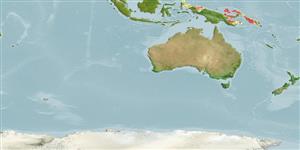>
Gobiiformes (Gobies) >
Gobiidae (Gobies) > Gobiinae
Etymology: Eviota: No etymology given, suggested by Christopher Scharpt: from Latin 'eu' for 'true' and 'iota' for anything very small, in combination 'truly very small' referring to it as being the smallest vertebrate at the time it has benn described by Jenkins (thus, making the suggestion by Scharpt plausible.; brahmi: Named for Brahm Kai Erdmann, who recognized that the species had been incorrectly identified as E. nigriventris in literature; a noun in the Latin genitive case..
Environment: milieu / climate zone / depth range / distribution range
Sinh thái học
Biển Cùng sống ở rạn san hô; Mức độ sâu 0 - 20 m (Ref. 95677). Tropical
Western Pacific: Papua New Guinea.
Bộ gần gũi / Khối lượng (Trọng lượng) / Age
Maturity: Lm ? range ? - ? cm
Max length : 1.7 cm SL con đực/không giới tính; (Ref. 95677); 1.5 cm SL (female)
Short description
Hình thái học | Sinh trắc học
Các tia vây lưng cứng (tổng cộng): 7; Các vây lưng mềm (tổng cộng): 9-11; Tia cứng vây hậu môn 1; Tia mềm vây hậu môn: 8 - 10. This species is distinguished from its congeners by the following characters: entire lower body with a red stripe, from the eye back to caudal-fin base where it grades into black ending in a dorsally asymmetrical spot that angles sharply towards the ventral portion of the caudal fin; pectoral-fin base with line of small black dots extending down to its base, the upper half are larger and more intense, the ones on the lower half smaller, less intense, and expanded across lower part of the base; cephalic sensory pore system lacking the PITO and IT pores and the AITO pore is enlarged; usually 10/9 dorsal/anal fin-ray formula; simple pectoral-fin rays; in both sexes the spinous dorsal-fin elongate or filamentous; genital papilla nonfimbriate. In life, the ventral red stripe is bordered dorsally by a bright white stripe that runs from the top of the head back to the caudal fin where it curves down following the angled black spot; the eye without a narrow white line on the iris above the pupil; a wide white line extends up the interorbital area, the width of the line extending from eye to eye (Ref. 95677).
Life cycle and mating behavior
Chín muồi sinh dục | Sự tái sinh sản | Đẻ trứng | Các trứng | Sự sinh sản | Ấu trùng
Greenfield, D.W. and L. Tornabene, 2014. Eviota brahmi n. sp. From Papua New Guinea, with redescription of Eviota nigriventris (Teleostei: Gobiidae). Zootaxa 3793(1):133-146. (Ref. 95677)
IUCN Red List Status (Ref. 130435)
Threat to humans
Harmless
Human uses
Thêm thông tin
Age/SizeSự sinh trưởngLength-weightLength-lengthLength-frequenciesSinh trắc họcHình thái họcẤu trùngSự biến động ấu trùngBổ xungSự phong phúBRUVS
Các tài liệu tham khảoNuôi trồng thủy sảnTổng quan nuôi trồng thủy sảnCác giốngDi truyềnElectrophoresesDi sảnCác bệnhChế biếnNutrientsMass conversion
Các công cụ
Special reports
Download XML
Các nguồn internet
Estimates based on models
Preferred temperature (Ref.
123201): 28.7 - 29.4, mean 29 °C (based on 194 cells).
Phylogenetic diversity index (Ref.
82804): PD
50 = 0.5000 [Uniqueness, from 0.5 = low to 2.0 = high].
Bayesian length-weight: a=0.00708 (0.00333 - 0.01504), b=3.09 (2.92 - 3.26), in cm total length, based on LWR estimates for this (Sub)family-body shape (Ref.
93245).
Mức dinh dưỡng (Ref.
69278): 3.0 ±0.3 se; based on size and trophs of closest relatives
Thích nghi nhanh (Ref.
120179): Chiêù cao, thời gian nhân đôi của chủng quần tối thiểu là dưới 15 tháng (Preliminary K or Fecundity.).
Fishing Vulnerability (Ref.
59153): Low vulnerability (10 of 100).
